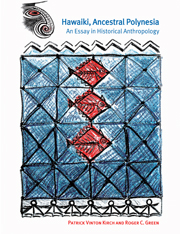Book contents
- Frontmatter
- Contents
- List of figures
- List of tables
- Preface
- List of language abbreviations
- Prologue: on historical anthropology
- Part I The phylogenetic model: theory and method
- Part II Rediscovering Hawaiki
- Introductory remarks
- 4 The Ancestral Polynesian world
- 5 Subsistence
- 6 Food preparation and cuisine
- 7 Material culture
- 8 Social and political organization
- 9 Gods, ancestors, seasons and rituals
- Epilogue: on history, phylogeny, and evolution
- Notes
- Glossary of terms
- References
- Subject Index
- Index of Proto Polynesian Reconstructions
9 - Gods, ancestors, seasons and rituals
Published online by Cambridge University Press: 06 January 2010
- Frontmatter
- Contents
- List of figures
- List of tables
- Preface
- List of language abbreviations
- Prologue: on historical anthropology
- Part I The phylogenetic model: theory and method
- Part II Rediscovering Hawaiki
- Introductory remarks
- 4 The Ancestral Polynesian world
- 5 Subsistence
- 6 Food preparation and cuisine
- 7 Material culture
- 8 Social and political organization
- 9 Gods, ancestors, seasons and rituals
- Epilogue: on history, phylogeny, and evolution
- Notes
- Glossary of terms
- References
- Subject Index
- Index of Proto Polynesian Reconstructions
Summary
The first process involved in building up Polynesian religion was the deification of ancestors… The souls of the Polynesian ancestors lived on in the spirit land of Hawaiki. Their descendants called upon them for assistance in the problems of this life. They wished for a continuity of help and so deified specific ancestors as gods who could be consulted when occasion demanded. Thus man created his gods.
hiroa 1939:9, 31In this, our final analytical chapter, we turn to a domain that prehistorians have always approached with caution, as in Hawkes' famous “ladder of inference” (Hawkes 1954). Cosmogony, religious beliefs, and the ritual practices of ancient societies may be inferred by archaeologists on the basis of textual or visual materials where these are available (usually only fully in the case of “state” level societies, and minimally in visual terms for the upper Palaeolithic), or from the remains of ceremonial or ritual facilities and precincts (temples, shrines, funerary remains, and so forth). For Ancestral Polynesia we have no such witnesses; the evidence of archaeology is for the present entirely mute. There are no extant Ancestral Polynesian temples or shrines, nor do we have funerary remains that might yield clues to ritual practice. No transparently sacred or ritual paraphernalia have been excavated from sites of this period. If asked to attempt a reconstruction of Ancestral Polynesian religion strictly on the basis of archaeological indications, we should have to reply that the task is currently impossible, and likely to remain intractable.
- Type
- Chapter
- Information
- Hawaiki, Ancestral PolynesiaAn Essay in Historical Anthropology, pp. 237 - 276Publisher: Cambridge University PressPrint publication year: 2001

